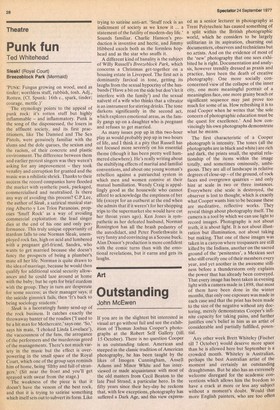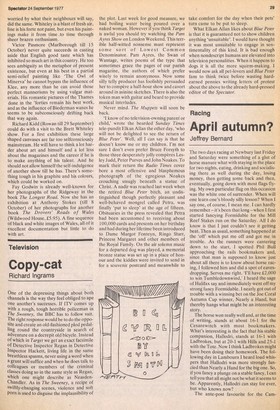Art
Outstanding
John McEwen
If you are in the slightest bit interested in visual art go without fail and see the exhibition of Thomas Joshua Cooper's photographs at the Robert Self Gallery (till, 15 October). There is no question Cooper is an outstanding talent. American and steeped in the classic tradition of American photography, he has been taught by the likes of Imogen Cunningham, Ansell Adams and Minor White and has interviewed or made acquaintance with most of the old masters from Cecil Beaton to the late Paul Strand, a particular hero. In the fifty years since their hey-day he reckons that, with few exceptions, photography has suffered a Dark Age, and this view express ed as a senior lecturer in photography at Trent Polytechnic has caused something of a split within the British photographic world, which he considers to be largely utilitarian in its aspiration, churning out documenters, observers and technicians but no artists. And on the evidence of most of the 'new' photography that one sees exhibited he is right. Documentation and analysis, however trendily dressed as praxis and practice, have been the death of creative photography. One more socially conconcerned 'view of thecollapse of the inner city, one more meaningful portrait of a meaningless face, one more grainy beach or significant sequence may just prove too much for some of us. How refreshing it is to read Cooper when he writes that 'the sole concern of photographic education must be the quest for excellence.' And how convincingly his own photographs demonstrate what he means.
The first characteristic of a Cooper photograph is intensity. The tones (all the photographs are in black and white) are rich and dark, the prints small, the spatial relationship of the items within the image totally, and sometimes ominously, ambiguous. They are all of landscape in relative degrees of close-up — of the ground, of rock faces and overgrown quarries — and only hint at scale in two or three instances. Everywhere else scale is destroyed, the observer is lost to thought, which is exactly what Cooper wants him to be because these are meditative, reflective works. They reveal things about photography itself. The camera is a tool by which we can use light to record images. Photography is not about truth, it is about light. It is not about illustration but illumination, not about taking but making. That one of these images was taken in a canyon where trespassers are still killed by the Indians, another on the sacred ground of the 'penitentes', a Mexican sect who still crucify one of their members every year, and yet another in the awesome stillness before a thunderstorm only explains the power that has already been conveyed. That every image has been taken in evening light with a camera made in 1898, that most of them have been done in the winter months, that only one exposure was made in each case and that the print has been made to the size of the negative without any doctoring, merely demonstrates Cooper's infinite capacity for taking pains, and further justifies one's belief in him as an artist of considerable and partially fulfilled, potential.
Any other week Brett Whiteley (Fischer till 7 October) would deserve more space than he is allowed here but September is a crowded month. Whiteley is Australian, perhaps the best Australian artist of the moment and certainly an outstanding draughtsman. But he also has an extremely welcome disregard for the academic conventions which allows him the freedom to have a crack at more or less any subject without a moment's doubt. Would that more English painters, who are too often worried by what their neighbours will say, did the same. Whiteley is a blast of fresh air, line is his forte not paint, but even his paintings make it from time ,to time through sheer brazen enthusiasm.
Victor Pasmore (Marlborough till 15 October) never quite succeeds in casting aside that English good taste which has inhibited so much art in this country. He too sees ambiguity as the metaphor of present existence, but even at his best in a partial semi-relief painting like 'The Owl of Minerva' he cannot bypass the influence of Klee, any more than he can avoid those perfect mannerisms by using vulgar materials. His romantic pictures of the Thames done in the 'forties remain his best work, and as the influence of B ie de rm an wanes he seems to be subconsciously drifting back that way again.
Richard Kidd (Rowan till 29 September) could do with a visit to the Brett Whiteley show. For a first exhibition these large shaped canvases are far too selfconsciously mainstream. He will have to think a lot harder about art and himself and a lot less about the magazines and the career if he is to make anything of his talent. And he should not allow himself the self-indulgence of another show till he has. There's something tough in his graphite and his colours, which could be worked on.
Fay Godwin is already well-known for her photographs of the Ridgeway in the book The Longest Road. Now she has an exhibition at Anthony Stokes (till 8 October) of her photographs for another book The Drovers' Roads of Wales (Wildwood House, /5.95). A fine sequence of black and white images of Wales, all of it excellent documentation but little to do with art.



































 Previous page
Previous page